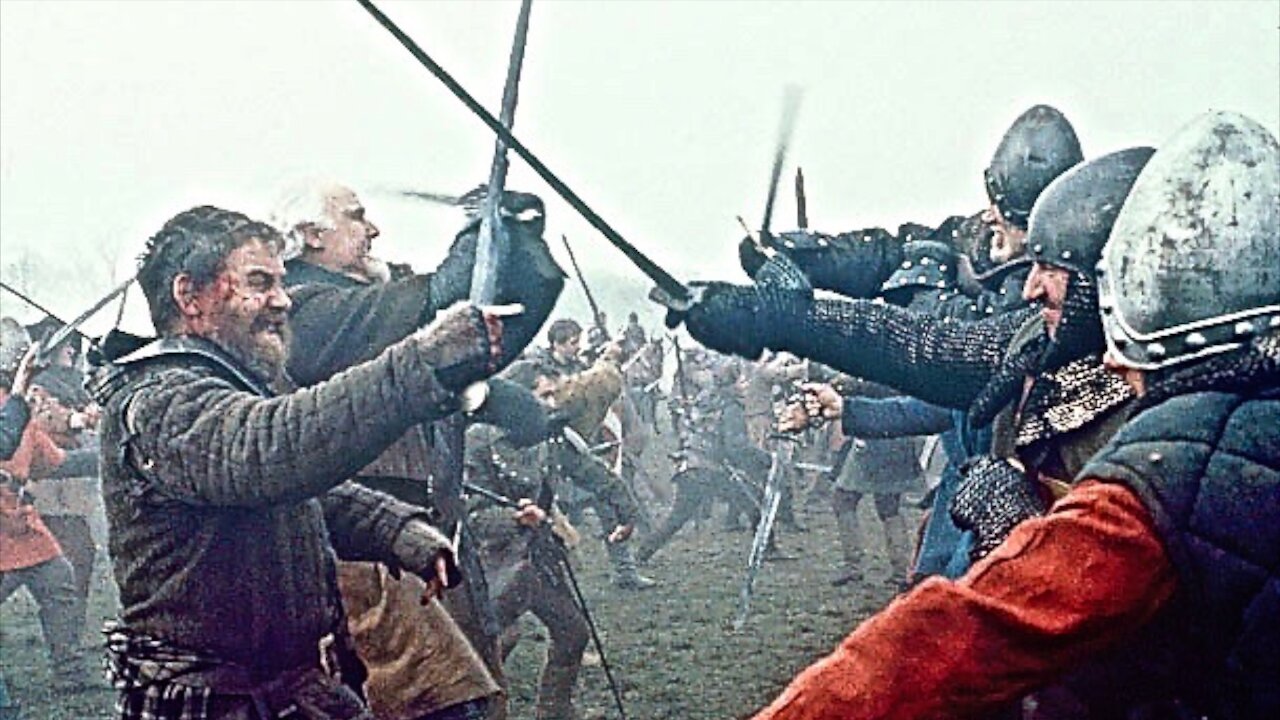Premium Only Content

The Most Famous Medieval Battle - AGINCOURT - Full Documentary
The Battle of Agincourt was a major English victory in the Hundred Years' War.The battle took place on Friday, 25 October 1415 (Saint Crispin's Day) in the County of Saint-Pol, Artois, some 40 km south of Calais (now Azincourt in northern France). Henry V's victory at Agincourt, against a numerically superior French army, crippled France and started a new period in the war during which Henry V married the French king's daughter, and their son, later Henry VI of England and Henry II of France, was made heir to the throne of France as well as of England. Henry V led his troops into battle and participated in hand-to-hand fighting. The French king of the time, Charles VI, did not command the French army himself as he suffered from severe psychotic illnesses with moderate mental incapacitation. Instead, the French were commanded by Constable Charles d'Albret and various prominent French noblemen of the Armagnac party.
This battle is notable for the use of the English longbow in very large numbers, with English and Welsh archers forming most of Henry's army. The battle is the centerpiece of the play Henry V by William Shakespeare.
Henry V invaded France following the failure of negotiations with the French. He claimed the title of King of France through his great-grandfather Edward III, although in practice the English kings were generally prepared to renounce this claim if the French would acknowledge the English claim on Aquitaine and other French lands (the terms of the Treaty of Brétigny). He initially called a Great Council in the spring of 1414 to discuss going to war with France, but the lords insisted that he should negotiate further and moderate his claims. In the following negotiations Henry said that he would give up his claim to the French throne if the French would pay the 1.6 million crowns outstanding from the ransom of John II (who had been captured at the Battle of Poitiers in 1356), and concede English ownership of the lands of Normandy, Touraine, Anjou, Brittany and Flanders, as well as Aquitaine. Henry would marry Princess Catherine, the young daughter of Charles VI, and receive a dowry of 2 million crowns. The French responded with what they considered the generous terms of marriage with Princess Catherine, a dowry of 600,000 crowns, and an enlarged Aquitaine. By 1415, negotiations had ground to a halt, with the English claiming that the French had mocked their claims and ridiculed Henry himself. In December 1414, the English parliament was persuaded to grant Henry a "double subsidy", a tax at twice the traditional rate, to recover his inheritance from the French. On 19 April 1415, Henry again asked the Great Council to sanction war with France, and this time they agreed.
Henry's army landed in northern France on 13 August 1415, carried by a fleet described by Shakespeare as "a city on the inconstant billows dancing / For so appears this fleet majestical", often reported to comprise 1,500 ships, but probably far smaller, and besieged the port of Harfleur with an army of about 12,000, and up to 20,000 horses. The siege took longer than expected. The town surrendered on 22 September, and the English army did not leave until 8 October. The campaign season was coming to an end, and the English army had suffered many casualties through disease. Rather than retire directly to England for the winter, with his costly expedition resulting in the capture of only one town, Henry decided to march most of his army (roughly 9,000) through Normandy to the port of Calais, the English stronghold in northern France, to demonstrate by his presence in the territory at the head of an army that his right to rule in the duchy was more than a mere abstract legal and historical claim. He also intended the manoeuvre as a deliberate provocation to battle aimed at the dauphin, who had failed to respond to Henry's personal challenge to combat at Harfleur.
The French hoped to raise 9,000 troops, but the army was not ready in time to relieve Harfleur. After Henry V marched to the north, the French moved to block them along the River Somme. They were successful for a time, forcing Henry to move south, away from Calais, to find a ford. The English finally crossed the Somme south of Péronne, at Béthencourt and Voyennes and resumed marching north. Without a river obstacle to defend, the French were hesitant to force a battle. They shadowed Henry's army while calling a semonce des nobles, calling on local nobles to join the army. By 24 October, both armies faced each other for battle, but the French declined, hoping for the arrival of more troops. The two armies spent the night of 24 October on open ground. The next day the French initiated negotiations as a delaying tactic, but Henry ordered his army to advance and to start a battle that, given the state of his army, he would have preferred to avoid, or to fight defensively: that was how Crécy and the other famous longbow victories had been won.
#history
#knights
#king
-
 3:29
3:29
Seeker Land
2 months agoKnock Out Pesky Spy Drones With This Portable Electromagnetic Pulse Weapon
61 -
 1:56:31
1:56:31
The Pascal Show
17 hours ago $2.35 earnedGHISLAINE FLIPS?! DOJ Receives SECRET LIST of 100 Epstein Associates!”
9.1K2 -
 10:17
10:17
Dr Disrespect
11 days agoIt's Time To Get Serious
180K27 -
 2:15:09
2:15:09
Badlands Media
1 day agoDevolution Power Hour Ep. 375: Obama’s Orders, Ukraine’s Collapse & the Inversion of Justice
298K107 -
 2:32:03
2:32:03
BlackDiamondGunsandGear
13 hours agoAFTER HOURS ARMORY w/ DLD & John from GOA & FLR
29.7K3 -
 1:05:28
1:05:28
Man in America
14 hours agoTREASON? Obama, Hillary, and Soros in the New World Order Agenda EXPOSED w/ Mel K
92.3K82 -
 2:22:46
2:22:46
The Connect: With Johnny Mitchell
15 hours ago $7.03 earnedOne Man's Mission To Stop Human Trafficking: How A Billionaire Mercenary Saved Hundreds Of Children
27.1K18 -
 2:35:13
2:35:13
Tundra Tactical
10 hours ago $14.16 earned🔫 California Ammo Win, Sig Sauer P320 Controversy, Meme Review & Would You Rather! 🎉🔥
42.6K6 -
 16:24
16:24
Forrest Galante
8 hours ago6 Deadliest Man Eaters to Ever Exist
29.8K9 -
 10:14
10:14
MattMorseTV
13 hours ago $16.21 earnedThe EU is in HOT WATER.
97.7K60